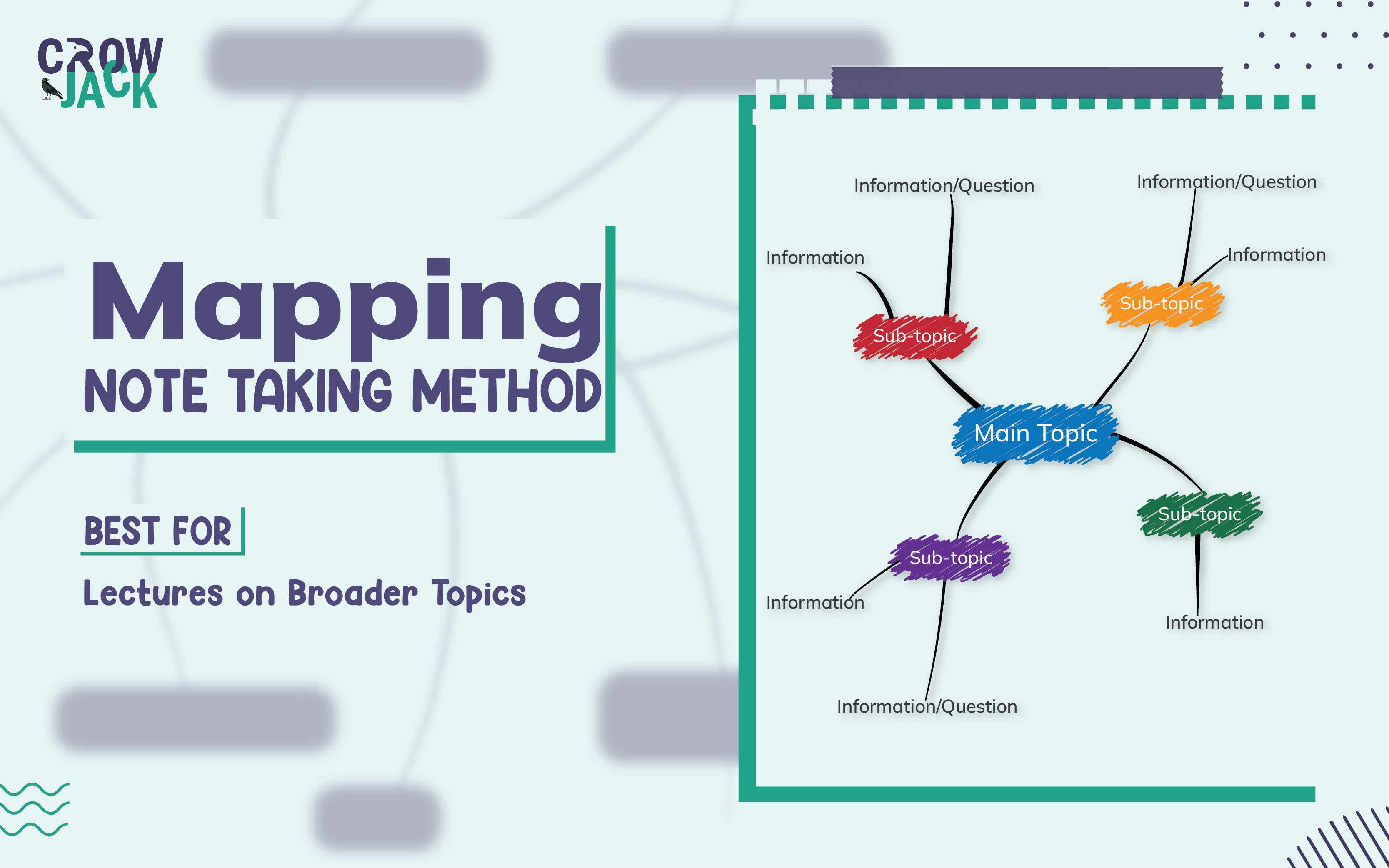Overview of the Mind Mapping Method
The concept mapping method is a visual note-taking technique used to organize and represent academic information in a diagrammatic form. Consider the mapping method as a spider weaving a web (connecting ideas with concepts and relationships). Imagine you are the spider spinning the web of notes and connecting it with one another to develop an extensive pattern. This note-taking method is most appropriate for academic lectures on broader topics. Such as Management Styles, Porter generic strategies, and Leadership theories.
Table of Contents
Difficulty level: Hard
Process of the Mind Mapping Method
1. Identify the central topic: Choose a central topic or concept that you want to explore and create a mind map around it. In this case, the central topic is "Proteins."
Example: Write "Proteins" at the center of your mind map.
2. Generate main branches: Identify the main categories or subtopics related to the central topic. These main branches will radiate out from the central topic and form the primary organizational structure of your mind map.
Example: Create main branches for "Structure," "Functions," "Types," and "Sources" of proteins extending from the central topic.
3. Add sub-branches: For each main branch, add sub-branches to further expand on the specific aspects or subtopics within that category. These sub-branches will provide more detailed information and examples.
Example:
- Under the "Structure" branch, add sub-branches for "Amino Acids," "Peptide Bonds," and "Protein Folding."
- Under the "Functions" branch, add sub-branches for "Enzymes," "Transport," and "Cell Signaling."
- Under the "Types" branch, add sub-branches for "Fibrous Proteins," "Globular Proteins," and "Membrane Proteins."
- Under the "Sources" branch, add sub-branches for "Animal Sources," "Plant Sources," and "Alternative Sources."
4. Explore further sub-branches: If necessary, continue adding sub-branches to each level to delve deeper into specific details, examples, or related concepts.
Example: Under the "Enzymes" sub-branch, add further sub-branches for "Digestive Enzymes," "Metabolic Enzymes," and "Proteolytic Enzymes."
5. Use visual elements: Utilize colors, icons, symbols, or images to enhance your mind map and make it visually appealing and easier to understand. These visual elements can help you make connections, highlight important information, or represent different categories.
Example: Use different colors to distinguish between the main branches, and include icons or symbols to represent different sources of protein, such as a cow icon for animal sources and a leaf icon for plant sources.
6. Review and refine: Once you have completed your mind map, take a moment to review and refine it. Ensure that all the main categories, subtopics, and relevant information are captured accurately and coherently.
Example:Review your mind map to verify that all the major aspects of proteins, including structure, functions, types, and sources, are adequately represented. Make any necessary revisions or additions for clarity and completeness.
Pros & Cons of the Mind Mapping Method
Pros
1. Creativity Booster: Mind maps stimulate creative thinking by allowing you to visually connect ideas and concepts in a non-linear fashion.
2. Visual Representation: The method offers a visual overview of your thoughts, making it easier to comprehend complex relationships.
3. Memory Enhancement: The visual and spatial elements of mind mapping aid memory retention.
Cons
1. Lack of Detail: Mind maps tend to focus on the bigger picture and may not capture intricate details.
2. Limited for Linear Content: It might not be ideal for capturing notes that follow a strict chronological or sequential order.
When to use the mind mapping method for note taking

The mind mapping is a versatile note-taking method that can be adapted to various situations. It promotes your creativity, critical thinking, and holistic understanding, making it a valuable tool in many contexts. Let's explore the different scenarios where you can benefit from using the mind mapping method.
1. Brainstorming and generating ideas: The mind mapping method is ideal for your brainstorming sessions and generating ideas. It allows you to visually represent and explore connections between concepts, helping you generate new insights and think creatively.
2. Organizing complex information: When you're dealing with complex information or subjects that have multiple interrelated components, mind maps are valuable for organizing and structuring the content. The visual nature of mind maps helps you see the big picture while also capturing the details in a cohesive and accessible format.
3. For effective studying: As we have discussed above, mind mapping is effective for your note-taking during lectures. Not just that, it can help you in academic presentations, or when studying from textbooks. They enable you to capture key points, summarize information, and make connections between different topics or subtopics.
4. Problem-solving and decision-making: The mind mapping method can assist you in your problem-solving and decision-making processes. It allows you to analyze a problem or decision from various angles, explore potential solutions or options, and visualize the relationships between different factors.
5. Presentations and communication: Mind maps can be used as visual aids during your presentations or when communicating complex ideas. They provide a concise and visually appealing way to present information, making it easier for your audience to understand and engage with the content.
6. Learning and teaching: Mind maps are beneficial for both your learning and teaching. As a learner, creating mind maps helps you organize and internalize information. As a teacher or facilitator, using mind maps can enhance the learning experience for your students by presenting information in a structured and visually engaging manner.
7. Personal organization and planning: Mind maps can be employed for your personal organization and planning purposes. They are useful for setting goals, outlining projects, creating to-do lists, and managing personal or professional tasks.

 Proof Reading
Proof Reading  Copy Writing
Copy Writing  Resume Writing
Resume Writing  Blogs
Blogs Guides
Guides SOP's
SOP's Student Resources
Student Resources Research Topics
Research Topics Login
Login Register
Register